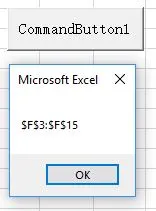许多答案在给定范围连续的情况下都可以工作。这是我会用于您绝对确定将是连续的范围:
Sub test()
Dim myRng As Range, lastCell As Range
Set myRng = Range("A1:D4")
Set lastCell = myRng.Cells(myRng.Rows.Count, myRng.Columns.Count)
Debug.Print lastCell.Address 'returns $D$4
End Sub
对于非连续的情况,DB用户10082797提供了一个很好的解决方案,但是当范围被对角线上升放置时,他们的函数会失败(例如,如果您传递rng=A3:B4,C1:D2,则输出为D4,这不是原始范围的一部分。)
因此问题变成了,范围A3:B4,C1:D2中的最后一个单元格是什么?是B4还是D2?这是程序员的决定。这是我根据DB用户10082797的函数编写的一个函数:
Function LastCellOfRange(rng As Range, Optional returnLastRow As Boolean = True) As Range
'returns the last cell in @rng.
'if @returnLastRow is TRUE, then the output will always be in the right most cell of the last row of @rng
'if @returnLastRow is FALSE, then the output will always be in the bottom most cell of the last column of @rng
'(@returnLastRow only matters for non-contiguous ranges under certain circumstances.)
'initialize variables
Dim area As Range, areaIdx As Long
Dim lastCellInArea As Range
'loop thru each area in the selection
For areaIdx = 1 To rng.Areas.Count
Set area = rng.Areas(areaIdx) 'get next area
Set lastCellInArea = area.Cells(area.Rows.Count, area.Columns.Count) 'get the last cell in the area
'if:
' the return is empty
' OR if the last row needs to be returned and this row is larger than the last area's
' OR if the last row needs to be returned and this row is the same as the last area's but has a larger column
' OR if the last column needs to be returned and this column is larger than the last area's
' OR if the last column needs to be returned and this column is the same as the last area's but has a larger row
'THEN:
' make this cell the return range
If LastCellOfRange Is Nothing Then
Set LastCellOfRange = lastCellInArea '(must be seperate from the other statment when its not set to anything)
ElseIf _
returnLastRow = True And lastCellInArea.Row > LastCellOfRange.Row _
Or returnLastRow = True And lastCellInArea.Row = LastCellOfRange.Row And lastCellInArea.Column > LastCellOfRange.Column _
Or returnLastRow = False And lastCellInArea.Column > LastCellOfRange.Column _
Or returnLastRow = False And lastCellInArea.Column = LastCellOfRange.Column And lastCellInArea.Row > LastCellOfRange.Row _
Then
Set LastCellOfRange = lastCellInArea
End If
Next areaIdx
End Function
您可以像这样使用该函数:
Sub test()
Dim myRng As Range
Set myRng = Range("A3:B4,C1:D2")
Debug.Print LastCellOfRange(myRng).Address 'returns $B$4
Debug.Print LastCellOfRange(myRng, False).Address 'returns $D$2
End Sub
